Unusual rain in Australia started within days of the Hunga Tonga dust cloud travelling across the continent…
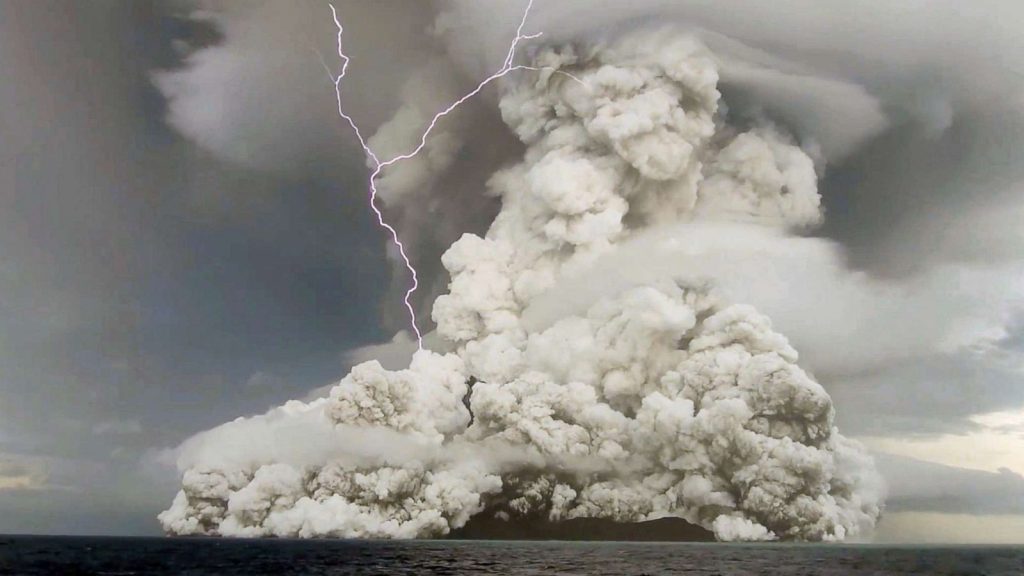
On January 15th, Hunga Tonga launched a magma-powered thunderstorm that sent atmospheric shockwaves around the world. Ash, salt and particulates were carried through rising columns, right through the stratosphere, into the mesosphere and all the way up to 58 kilometers above Earth. For hours 400,000-odd lighting bolts zapped the airborne chemical soup.
The dust from Hunga-Tonga travelled West and reached Australia on Jan 18 – 20th. On Jan 21-22 flooding rain washed out the main railway line and roads in central Australia. Over the next few weeks, rains soaked the ground across parts of Queensland and New South Wales. By February 15th, the remnant volcanic dust that had circled the Earth and was back again creating rich red sunsets over Australia. A week or so after that, the rain bombs fell on South East Queensland, and travelled south through New South Wales to Sydney.
The big unknown is that the Hunga-Tonga volcano launched water vapor, salt and dust incredibly high — almost too high. The aerosols are far above the troposphere where rainfall originates and some of that floating ash was still too high even as it returned on the second lap of the Earth at 25km above sea level. On the other hand, some particles will fall out faster than others, others will be highly charged and possibly novel entities created in the monster lightning storm above the volcano, and some ash and particles will have been released at lower heights.
This post was inspired by Jennifer Marohasy who pointed out the weak La Nina conditions don’t really explain the floods in Australia this year. She wondered if the recent Australian rain was fueled by aerosols from Hunga Tonga and describes how rainfall has been linked to past eruptions in scientific papers: after “El Chichon spewed 20 million tonnes of aerosols into the stratosphere in 1982, Hong Kong recorded very high rainfalls as the dust arrived across the Pacific”.
PROTECT YOUR HOME AND CAR WITH THE BEST LIGHTNING AND EMP PROTECTION AVAILABLE…
The volcanic dust passes over Australia on Jan 18 -20
Hunga Tonga lies 20 degrees south of the equator at roughly the same latitude as Townsville in Queensland. So the densest band of aerosols circling the Earth westwards from the eruption would track right over Queensland.
Updating SO2 emissions of #HungaTongaHungaHaapai. The huge plume of sulphur dioxide was detected today, Jan. 18 by the #Copernicus #Sentinel5p #Tropomi sensor over Northern #Australia, keeping moving westward. #Tonga #TongaVolcanoEruption #AirQuality @WMO @BOM_WA @smitchell_sci pic.twitter.com/YZOnAIZTlw
— ADAM Platform (@PlatformAdam) January 18, 2022
The volcanic dust cloud travelled west, arriving over Australia on January 18th and reaching the Indian Ocean on the far side by January 20th. It was dissipating as it moved, but could have left a trail of cloud seeding particles in the stratosphere over Australia. These in turn will be falling and blowing with the wind, spreading out through the Southern Hemisphere.
PROTECT YOUR HOME AND CAR WITH THE BEST LIGHTNING AND EMP PROTECTION AVAILABLE…
Strange rainfall patterns Across Australia in the week after the dust went through
On Jan 21 and 22, flooding in the arid zones of South Australia was so severe, it washed out the one trans Australian railway line and the Stuart Highway as well. And this was in midsummer in an area that rarely gets any rain. Rainfalls in some areas of South Australia were 400% higher than normal.
Perhaps some parts of these falls were too far south, and perhaps the dust just wasn’t low enough in the atmosphere at this point. But on the 16th of January there were slow surface and lower tropospheric winds blowing past parts of the Tonga cloud to the west.
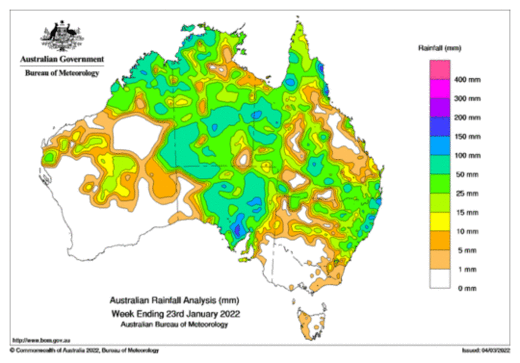
The downpour in central South Australia was so unusual it washed out the sole Trans-Australia “Indian Pacific” railway line running across the nation from East to West.
The line normally delivers 80% of Western Australia’s retail supplies on freight trains that are nearly 2km long. The line took weeks to be restored and the shelves here in Perth are still running empty in somewhat random patterns.
Flooding has damaged parts of the freight line across the Nullabor.
Across Australia the rain for the whole month of January was generally heavier than usual
There is usually very little rain in central Australia in the hottest month of the year. When there are big falls in the deserts it is usually due to the remnants of a cyclone. That doesn’t seem to be the case this time.
And most of the rain recorded on this map occurred after the dust passed over. The first two weeks of January were much drier.
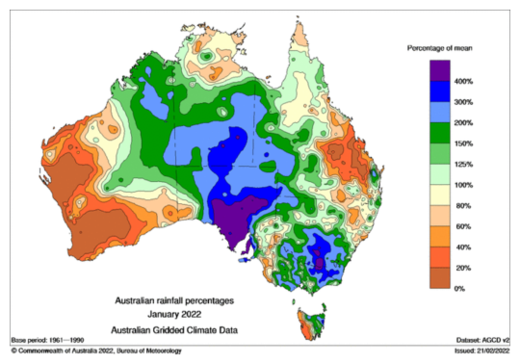
PROTECT YOUR HOME AND CAR WITH THE BEST LIGHTNING AND EMP PROTECTION AVAILABLE…
Hunga Tonga was the tallest, wettest, most violent storm in our lifetime
The eruption reached an astonishing 58 kilometers into the sky.
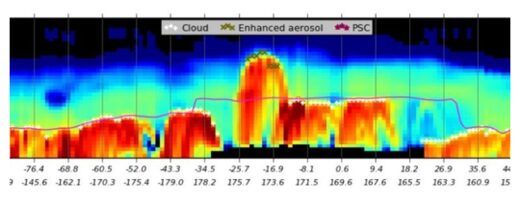
The underwater explosion made Hungo Tonga very different. Unlike Pinatubo or El Chichon, it didn’t carry a large weight of sulphur dioxide, but did carry a lot of water. The blast punched so far up into the atmosphere, because it was powered by a massive expansion of water vapor as the 20 degree water hit 1000 degree magma.
The steam powered column drove a mix of salt, ash and particulates right through the stratosphere and into the mesosphere. It was possibly the biggest thunderstorm on Earth. The rising column generated a phenomenal 400,000 lighting strikes over a seven hour period. That towering electrical morass must have generated a wild-card mix of aggressively charged particles, and at altitudes we never normally see them.
Who knows how long those zapped chemicals would take to drift back down to Earth and what mischief they might do on the way?
Lidar showed the sulphates and aerosols were back over Australia from Feb 15th:
“[It’s] showing us what is probably mostly sulphate aerosols (maybe a bit of volcanic ash) around 25 km in height in the stratosphere, sitting well above the troposphere where the clouds are,” according to Dr Tupper [of Natural Hazards Consulting]
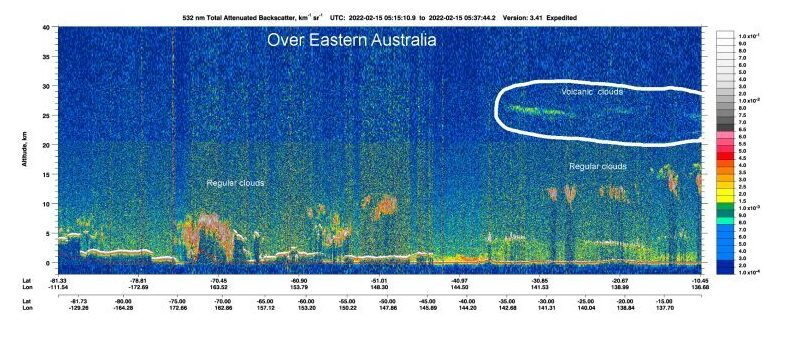
Since the initial explosion, the plume has been circling around the atmosphere, too high to affect our day-to-day weather, but adding a red glow to sunrises and sunsets. The plume has now roughly made its first full loop of the globe and has been travelling over Australia again this week.
“So that’s why we’ve seen these really glowing skies at sunrise and sunset,” Mr [Graham] Creed said.
“The interesting thing is that at sunset you can actually see the meteorological sunset, which is when the clouds change colour but as the sun goes over and it starts to go dark that’s when the volcanic ash was illuminated and was bending and refracting the light.”
Andrew Miskelly noted a haze in satellite images over Australia at the same time. Something is going on up there, but how much do we really know?
PROTECT YOUR HOME AND CAR WITH THE BEST LIGHTNING AND EMP PROTECTION AVAILABLE…
Hunga-Tonga isn’t expected to cool the climate much
The latest estimates of the effect of Hunga Tonga are that the cooling impact will be smaller, because the amount of sulfur dioxide was only 2% of what the Pinatubo eruption released. However the underwater explosion reached far up into the stratosphere, nearly 40km altitude, so those particulates may be suspended for a long time.
Indeed NASA estimates the plume even reached 58km at it’s highest point, right up into the Mesosphere. “The Tonga plume was 1.5 times the height of the Pinatubo plume.”
“When volcanic material goes this high into the stratosphere, where the winds are not as strong, the volcanic ash, sulfur dioxide, carbon dioxide, and water vapor can be transported all over Earth,” said Khlopenkov. Within two weeks, the main plume of volcanic material circled the globe, as observed by the Cloud-Aerosol Lidar and Infrared Pathfinder Satellite Observation (CALIPSO) satellite, as well as the Ozone Mapping and Profiler Suite on the Suomi-NPP satellite.
Aerosols from the plume have persisted in the stratosphere for nearly a month after the eruption and could stay for a year or more, said atmospheric scientist Ghassan Taha of NASA’s Goddard Space Flight Center.
“The combination of volcanic heat and the amount of superheated moisture from the ocean made this eruption unprecedented. It was like hyper-fuel for a mega-thunderstorm,” said Bedka. “The plume went 2.5 times higher than any thunderstorm we have ever observed, and the eruption generated an incredible amount of lightning. That is what makes this significant from a meteorological perspective.”
Updated animation of #S5p #tropomi SO2 measurements of the #HungaTongaHungaHaapai volcanic eruption from 14 to 25 January. Some orbit on 16 Jan are missing in the data stream. @tropomi @DLR_en @BIRA_IASB @ESA_EO #INPULS pic.twitter.com/0HuKuslNMk
— TROPOMI SO2 (@DlrSo2) January 25, 2022
PROTECT YOUR HOME AND CAR WITH THE BEST LIGHTNING AND EMP PROTECTION AVAILABLE…
The chemistry of a volcanic eruption on the climate
We don’t understand the sulphate chemistry of the climate very well:
The chemical reactions affecting both the formation and elimination of sulfur aerosols are not fully understood. It is difficult to estimate accurately, for example, whether the presence of ash and water vapour is important for aerosol formation from volcanic products, and whether high or low atmospheric concentrations of precursor chemicals (such as SO2 and H2S) are optimal for aerosol formation. — Wikipedia
The cooling effect (due to SO2) will be smaller than most volcanoes:
The largest volcanic eruption of the last 500 years, the eruption of Mount Tambora in Indonesia in April 1815 caused the so-called “Year Without a summer” in the following year in many parts of the world. There is a reduction in annual mean surface temperature over the tropics and northern hemisphere by 0.4-0.8°C.
But the Tambora eruption emitted 53-58 terrograms (Tg) of SO2. Satellite measurements of the eruption at HTHH — which has erupted multiple times over the past century — showed that its volcanic ash has reached an altitude of 30 kilometers deep into the stratosphere, with a total mass of only about 0.4 Tg.
….the 1991 explosive eruption of Mount Pinatubo in the Philipines produced a cooling of about 1.1 degree F (0.6 degree C) that lasted for nearly two years. But the ash spewed into the air by Mount Pinatubo contained about 50 times as much sulfur dioxide as the cloud produced by Hunga Tonga.
The usual models of volcanoes have no prior event like Hunga Tonga to use to make predictions from. The cooling effect may well be due to salt or charged particles, and who knows what that water vapor will do up in the Mesosphere?
PROTECT YOUR HOME AND CAR WITH THE BEST LIGHTNING AND EMP PROTECTION AVAILABLE…
Hunga-Tonga was like a 4 to 18 megaton TNT bomb
This is a preliminary estimate, but we think the amount of energy released by the eruption was equivalent to somewhere between 4 to 18 megatons of TNT,” said Garvin, chief scientist at NASA’s Goddard Space Flight Center. “That number is based on how much was removed, how resistant the rock was, and how high the eruption cloud was blown into the atmosphere at a range of velocities.”
The blast released hundreds of times the equivalent mechanical energy of the Hiroshima nuclear explosion. For comparison, scientists estimate Mount St. Helens exploded in 1980 with 24 megatons and Krakatoa burst in 1883 with 200 megatons of energy.
Most Surtseyan style eruptions involve a relatively small amount of water coming into contact with magma. “If there’s just a little water trickling into the magma, it’s like water hitting a hot frying pan. You get a flash of steam and the water burns burn off quickly,” explained Garvin.
“What happened on the 15th was really different. We don’t know why — because we don’t have any seismometers on Hunga Tonga-Hunga Ha’apai — but something must have weakened the hard rock in the foundation and caused a partial collapse of the caldera’s northern rim. Think of that as the bottom of the pan dropping out, allowing huge amounts of water to rush into an underground magma chamber at very high temperature.”
The temperature or magma usually exceeds 1000 degrees Celsius; seawater is closer to 20°C. The mixing of the two can be incredibly explosive, particularly in the confined space of a magma chamber. “This was not your standard Surtseyan eruption because of the large amount of water that had to be involved,” said Garvin. “In fact, some of my colleagues in volcanology think this type of event deserves its own designation. For now, we’re unofficially calling it an ‘ultra Surtseyan’ eruption.” [JoNova]
StrangeSounds.org has been banned from ADS NETWORKS! CLICK HERE TO DONATE AND SUPPORT ME, MY WORK AND MY WEBSITE!
NOW PREPARE FOR THE NEXT NATURAL DISASTER AND EMERGENCY:
PROTECT YOUR HOME AND CAR WITH THE BEST LIGHTNING AND EMP PROTECTION AVAILABLE…
DRINK CLEAN WATER USING THE BEST HOME WATER FILTER AROUND…
You should really subscribe to QFiles. You will get very interesting information about strange events around the world.


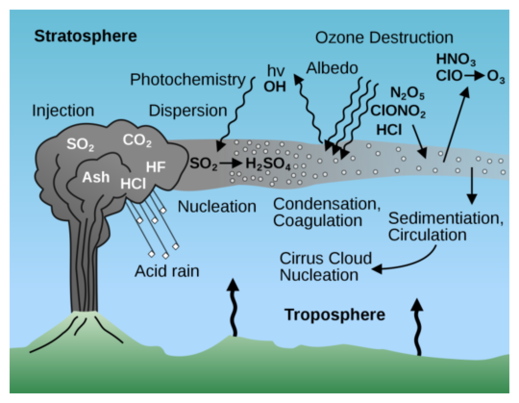











No, it would had been more widespread and other countries would had been affected too… they were using HAARP to cause the floods in QLD.